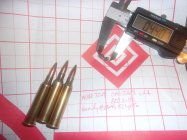RCBS and possibly other die makers will make an inside neck case reamer on request; at least they used to. I have not used one, or seen one used. I assumed (incorrectly) that you were referring to outside neck turning. Both of these are processes only used by more advanced reloaders. And my comments are really directed as much at accomplished reloaders as at novices. I did not include anything expensive or complicated, and that's the reason. As I mentioned, I like simple tools used correctly, and I'm basically "daring" people to match my ammo specs and performance with anything they can bring. I'll learn given the right information; and I might change my process for a reason. I mentioned testing annealing, and I found two videos from AMP, Annealing Made Perfect, who makes an induction annealer that is an excellent piece of equipment, if you can afford it. One video is Lou Murdica shooting annealed cases for 20 shots, and comparing non-annealed cases. The non-annealed cases got a group of 0.50". The annealed cases got a 20-shot 0.35" group. Lou is a benchrest shooter who has an indoor range which is 100 yds. His video is apples to oranges, though, since the rifles were different. The results are only valid when comparing the same load in the same rifle, with the same shooter, in the same conditions. So that does not qualify as valid for my purposes. The second video is at 1,000 yards, and shows two groups shot from the same rifle by the same shooter, with the same load, except one is annealed and the other group is not. But he only fired 5 shots, which is not enough to qualify as a valid test. The annealed group looked very much better, though. But 1,000 yard groups in F-class are 20 shots. So the test still needs to be done.
BTW, I only name-dropped the elites so as to provide names of people who win matches, and might be willing to say whether they neck turn or anneal.
If I'm still missing something about your question, hit me again, and I'll eventually understand how to respond properly. I used to be a flight instructor, and the students always wanted me to teach them the advanced stuff. My response was always that "the basics" IS the advanced stuff, and that mastery of the basics equals mastery PERIOD! I honestly think that my processes are simpler and as good as any, and would be the way I'd recommend for a newbie to start out.
Back to neck reaming, or inside neck turning, I would be concerned that the cutting process would leave marks inside the case neck, which could damage the bullet as it is being seated. For that reason, I would not recommend inside neck turning.











